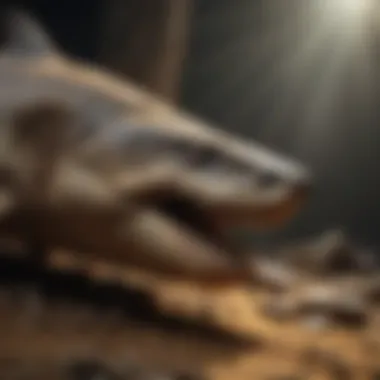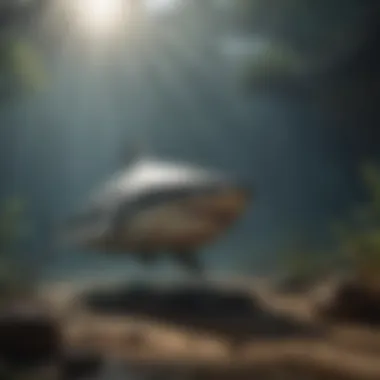Unveiling the Enigmatic Megalong Shark: A Dive into Prehistoric Secrets


Rock and Fossil Identification
In the quest to unravel the mysteries surrounding the Megalong Shark, understanding rock and fossil identification plays a pivotal role. Identifying the right types of rocks and fossils that potentially hold clues to the existence of this colossal marine creature is vital. When examining rocks, key characteristics to look for include texture, color, and composition, while with fossils, details like structure, imprint, and mineralization matter significantly. Utilizing tools such as geological hammers, chisels, and magnifying lenses can aid collectors in the precise identification of rock formations and fossil specimens.
Collecting Tips and Techniques
For aspiring rock and fossil collectors intrigued by the Megalong Shark's existence, mastering the art of collecting is essential. Adopting best practices such as conducting thorough research, obtaining the necessary permits, and respecting the environment are foundational steps. Discovering prime collecting sites, which are often near ancient oceanic deposits or geological formations, increases the likelihood of unearthing significant rock and fossil specimens linked to the Megalong Shark. Safely extracting these artifacts demands patience, precision, and the use of appropriate tools like brushes, dental picks, and gloves to avoid damaging delicate finds.
Preservation and Display
Once collectors obtain rock and fossil specimens related to the Megalong Shark, preserving them becomes paramount. Employing techniques like cleaning with brushes or air scribes, consolidating fragile fossils with adhesives, and storing in acid-free containers helps maintain the integrity of these historical artifacts. Proper storage methods involve keeping specimens in a cool, dry environment to prevent deterioration or damage over time. For creative display ideas, considerations like arranging fossils in chronological order, constructing themed dioramas, or using backlighting to showcase details can enhance the visual appeal and educational value of the collection.
Geological Insights
To gain a deeper understanding of the Megalong Shark's presence in ancient oceans, delving into geological insights is crucial. Exploring geological formations linked to the shark's habitat, studying the fossil record from various eras, and deciphering the consequences of environmental changes over time provide valuable context. Recognizing the historical significance of rocks and fossils associated with the Megalong Shark sheds light on past ecosystems, evolutionary developments, and possibly the reasons behind the creature's mysterious extinction. Notable discoveries in the field, whether in paleontological studies or geological surveys, contribute to advancing scientific knowledge and unravelling the enigmatic legacy of the Megalong Shark.
Introduction
The enthralling world of the Megalong Shark beckons us to dive into the depths of prehistory, unveiling mysteries shrouded in time. This article serves as a beacon, illuminating the path to understanding a creature that once dominated the ancient oceans with its colossal presence. By delving into the tale of the Megalong Shark, we unravel a narrative that not only captures the essence of a bygone era but also offers profound insights into the intricate webs of marine ecosystems. As we embark on this journey of discovery, we are bound to be captivated by the enigma that is the Megalong Shark.
The Megalong Shark: A Historical Enigma
The Origins of the Megalong Shark
The genesis of the Megalong Shark stands as a testament to the evolutionary marvels that have shaped our planet over millennia. A pivotal figure in the annals of prehistoric marine life, the origins of the Megalong Shark trace back to a time when colossal predators roamed the ancient seas. This section delves deep into the primordial roots of this majestic creature, shedding light on its evolutionary history and the defining factors that set it apart from its marine counterparts.
Significance of Megalong Shark Fossils in Paleontology
The Megalong Shark fossils serve as priceless relics that not only bridge the gaps in our understanding of ancient marine fauna but also offer pivotal clues into the broader tapestry of paleontological research. These fossils are not merely imprints in stone; they are windows to a world long past, providing invaluable insights into the evolutionary trajectories of marine predators. Through a meticulous examination of these fossilized remains, scientists have pieced together a narrative that transcends time, offering a glimpse into the enigmatic life of the Megalong Shark.
Scope of the Article
Exploring Megalong Shark's Anatomy
Embark on a riveting journey through the anatomical wonders of the Megalong Shark, unravelling the intricate structures that endowed it with unparalleled predatory prowess. From its monumental size to the adaptive features that facilitated its dominance in the ancient seas, this section offers a detailed exploration of the physical attributes that defined the Megalong Shark. By dissecting its anatomy with surgical precision, we gain a comprehensive understanding of the evolutionary marvel that was the Megalong Shark.


Theories on Megalong Shark's Extinction
The question of the Megalong Shark's demise looms large, casting a shadow over its once-glorious reign in the primordial oceans. This section delves into the myriad theories that seek to elucidate the enigma of its extinction, ranging from environmental shifts to evolutionary pressures. By unraveling the complex tapestry of factors that might have led to the Megalong Shark's downfall, we confront the harsh realities of nature's relentless march, challenging the very essence of survival in an ever-changing world.
Ancient Behemoth: Anatomy of the Megalong Shark
In the exploration of the Megalong Shark, the section focusing on the 'Ancient Behemoth: Anatomy of the Megalong Shark' holds paramount importance. It serves as a foundational pillar within the broader narrative of unveiling the mysteries of this prehistoric marine giant. By delving into the intricate details of the Megalong Shark's anatomy, we gain invaluable insights into its evolutionary adaptations, behavioral patterns, and ecological interactions.
Physical Characteristics
Gigantic Size and Proportions
Delving into the enigmatic world of the Megalong Shark's 'Gigantic Size and Proportions' unravels a tapestry of evolutionary marvel. Its colossal dimensions not only captivate the imagination but also hold crucial implications for understanding its predatory prowess and ecological niche. The sheer scale of the Megalong Shark's body provides a glimpse into the evolutionary pressures that shaped its form, making it a compelling focal point for this article. Exploring the nuances of its massive size offers a window into the ancient oceans and the dynamics that governed this apex predator.
Distinctive Features of Megalong Shark
The 'Distinctive Features of Megalong Shark' are a mosaic of biological marvels that set this ancient behemoth apart. From its unique dentition to specialized sensory organs, each feature encapsulates a chapter in the Megalong Shark's evolutionary journey. By unraveling these distinct attributes, we not only gain a deeper appreciation for its ecological role but also decipher clues about its feeding strategies and social interactions. The Megalong Shark's distinctive features serve as a testament to the intricate web of adaptations honed through millions of years of evolution.
Adaptations for Predatory Behavior
At the core of the Megalong Shark's success as a predator lie its 'Adaptations for Predatory Behavior.' These evolved traits underscore its efficiency in securing prey within the competitive realm of the ancient oceans. From tooth morphology suited for slicing through flesh to streamlined body contours enhancing swift movements, each adaptation paints a vivid picture of a lethal hunter at the top of the marine food chain. Analyzing these adaptations offers a glimpse into the evolutionary arms race that shaped the Megalong Shark's predatory arsenal, making it a focal point of intrigue and scientific inquiry within this article.
The Mystery of Extinction
The section focusing on 'The Mystery of Extinction' in this article about the Megalong Shark plays a pivotal role in unraveling the enigmatic fate of this ancient marine behemoth. By delving into the various factors that might have led to the extinction of the Megalong Shark, we can glean valuable insights into the dynamics of prehistoric ecosystems and the interplay of environmental changes and competitive pressures on this magnificent creature.
Environmental Factors
Impact of Climate Change
Exploring the Impact of Climate Change on the Megalong Shark's extinction sheds light on how shifts in environmental conditions could have disrupted the delicate balance of the ancient oceans. By examining the specific ramifications climate change may have had on the Megalong Shark's habitat, we can better understand the challenges it faced and the implications for its survival. This analysis provides a unique perspective on the broader implications of climate change on marine species and ecosystems, making it a crucial aspect of this article's exploration.
Ecosystem Dynamics
The discussion on Ecosystem Dynamics in relation to the Megalong Shark's extinction unveils the intricate web of relationships that governed prehistoric ecosystems. Understanding how changes in ecosystem dynamics, such as shifts in predator-prey dynamics or species interactions, influenced the fate of the Megalong Shark offers valuable insights into the complexities of ancient marine environments. By highlighting the nuances of ecosystem dynamics, we can grasp the interconnectedness of species and habitats, enriching our comprehension of the Megalong Shark's disappearance.


Competition and Evolutionary Pressures
Rise of Competing Marine Species
Examining the Rise of Competing Marine Species as a factor contributing to the Megalong Shark's extinction elucidates the intense competition that existed in ancient oceans. By assessing how the emergence of new marine species might have outcompeted the Megalong Shark for resources or habitats, we can paint a detailed picture of the evolutionary pressures it faced. This analysis underscores the dynamic nature of ancient marine ecosystems and the role of competition in shaping species' destinies.
Adaptability of Megalong Shark
Exploring the Adaptability of the Megalong Shark provides insights into its evolutionary resilience and response to changing environmental conditions. By delineating the key characteristics that enabled the Megalong Shark to thrive for millennia and the limitations it might have encountered in adapting to new challenges, we can appreciate the complexities of evolutionary processes. This examination offers a nuanced understanding of the Megalong Shark's biological capabilities and sheds light on the constraints it faced amid shifting landscapes.
Human Influence
Hunting and Exploitation
Investigating the impact of Hunting and Exploitation on the Megalong Shark population unveils the detrimental effects of human activities on ancient marine species. By scrutinizing the practices of hunting and exploitation that may have decimated Megalong Shark populations, we confront the grim realities of human intervention in prehistoric ecosystems. This exploration prompts reflection on the ethical and conservation implications of human endeavors on ancient megafauna, underscoring the importance of responsible stewardship of natural resources.
Anthropogenic Effects on Megalong Shark Population
Analyzing the Anthropogenic Effects on the Megalong Shark population illuminates the wide-ranging consequences of human actions on prehistoric marine life. By delineating the specific ways in which human activities could have impacted Megalong Shark populations, we confront the challenges of species preservation in the face of anthropogenic threats. This analysis provokes contemplation on the fragility of ecosystems in the wake of human influence and underscores the need for concerted conservation efforts to protect vulnerable species.
Unraveling the Fossil Record
In the vast realm of paleontology, the crucial aspect of unraveling the fossil record plays a pivotal role in shedding light on the intriguing mysteries surrounding the Megalong Shark. Delving deep into fossils allows us to piece together the enigmatic history of this colossal marine predator with meticulous detail and precision. By examining the remnants of ancient organisms preserved in sedimentary rock layers, scientists can reconstruct the evolutionary trajectory and ecological interactions of the Megalong Shark throughout its geologic reign.
Paleontological Discoveries
Ancient Megalong Shark Specimens
The discovery of ancient Megalong Shark specimens serves as a cornerstone in unraveling the mysteries of this prehistoric marine giant. These fossilized remains provide invaluable insights into the anatomical structure, behavioral patterns, and ecological dynamics of the Megalong Shark. Through careful examination of these well-preserved specimens, paleontologists can discern the massive size, distinctive features, and adaptive traits that enabled the Megalong Shark to reign supreme in ancient oceans. The analysis of ancient Megalong Shark specimens not only enriches our understanding of prehistoric marine ecosystems but also offers a glimpse into the evolutionary adaptations that shaped this formidable apex predator.
Fossilized Remains and Trace Fossils
The study of fossilized remains and trace fossils further enhances our comprehension of the Megalong Shark's enigmatic existence. Fossilized remains, comprising teeth, vertebrae, and fin spines, provide tangible evidence of the Megalong Shark's evolutionary lineage and predatory habits. Additionally, trace fossils such as bite marks and coprolites offer behavioral clues regarding the feeding strategies and social interactions of this ancient behemoth. These fossilized relics act as windows to the past, unveiling intricate details of the Megalong Shark's ecological role and evolutionary adaptations.
Technological Advancements


3D Reconstruction of Megalong Shark
The innovative technique of 3D reconstruction revolutionizes the study of the Megalong Shark by offering immersive visualizations of its anatomy and biology. Through advanced imaging technologies and digital modeling, scientists can create accurate representations of the Megalong Shark's skeletal structure and soft tissues. This detailed reconstruction enables researchers to explore the biomechanics, locomotion, and sensory capabilities of the Megalong Shark, providing unprecedented insights into its evolutionary traits and environmental adaptations. The 3D reconstruction of the Megalong Shark propels paleontological research into a new realm of precision and realism, allowing for enhanced interpretations of its ancient existence.
Isotopic Analysis for Dietary Insights
The utilization of isotopic analysis provides a gateway to deciphering the dietary preferences and trophic interactions of the Megalong Shark within ancient food webs. By analyzing stable isotopes present in fossilized tissues, researchers can infer the Megalong Shark's position in the marine food chain, its feeding habits, and its response to ecological shifts. Isotopic signatures preserved in fossilized remains offer a glimpse into the nutritional ecology of the Megalong Shark, unraveling mysteries regarding its foraging behaviors, migration patterns, and environmental adaptations. This analytical approach enhances our understanding of the Megalong Shark's ecological niche and evolutionary role within ancient ecosystems.
Conservation and Preservation Efforts
Role of Museums and Research Institutions
Museums and research institutions play a pivotal role in safeguarding and disseminating knowledge regarding the Megalong Shark and its paleontological significance. These entities serve as custodians of fossil specimens, curating exhibits and educational programs that showcase the legacy of the Megalong Shark to diverse audiences. Through research collaborations and public outreach initiatives, museums and research institutions contribute to the conservation of paleontological heritage, fostering appreciation for ancient marine creatures like the Megalong Shark and raising awareness about the importance of fossil preservation.
Legal Framework for Megalong Shark Fossil Protection
The establishment of a robust legal framework for Megalong Shark fossil protection is essential in safeguarding these invaluable relics from exploitation and destruction. Regulatory measures and conservation laws aim to prevent illegal excavation, trade, and export of Megalong Shark fossils, ensuring their scientific integrity and cultural value are preserved for future generations. By enacting legal protections and promoting ethical practices within the fossil trade, governmental bodies and conservation organizations contribute to the sustainable preservation of Megalong Shark specimens, enabling continued research and educational initiatives focused on this remarkable prehistoric predator.
Conclusion
In the culmination of this detailed exploration into the mysteries surrounding the Megalong Shark, it becomes evident that the significance of this topic extends far beyond mere paleontological curiosity. The insights gleaned from studying this prehistoric marine giant offer valuable lessons for understanding the dynamics of ancient marine ecosystems and provide crucial guidelines for modern conservation efforts. By synthesizing the information presented throughout the article, it is clear that the Megalong Shark represents a crucial link to our understanding of prehistoric marine ecology and biodiversity.
Implications of Megalong Shark Research
Insights for Prehistoric Marine Ecology
Delving into the specifics of the Megalong Shark's influence on prehistoric marine ecology showcases a groundbreaking field of research. The examination of fossil records and paleontological discoveries relating to this colossal creature sheds light on the interconnectedness of ancient marine ecosystems. By unraveling the dietary habits, behavioral patterns, and ecological role of the Megalong Shark, researchers gain invaluable insights into the dynamic nature of prehistoric seas. The depth and breadth of knowledge obtained from studying the Megalong Shark's ecological impact provide a solid foundation for understanding past environmental dynamics and offer predictive models for modern marine conservation efforts.
Lessons for Conservation and Biodiversity
The exploration of the Megalong Shark's legacy offers a unique perspective on the importance of conservation and biodiversity. By drawing parallels between the extinction of this ancient behemoth and current environmental challenges, valuable lessons emerge. Understanding the factors that led to the Megalong Shark's demise underscores the fragility of ecological balances and emphasizes the critical need for conservation measures. The Megalong Shark's story serves as a cautionary tale, reminding us of the delicate interplay between species survival, environmental changes, and human impact. By incorporating the lessons learned from the Megalong Shark into conservation strategies, we pave the way for a more sustainable coexistence with the natural world.
Future Prospects
Innovations in Paleontological Studies
The realm of paleontological studies stands to benefit greatly from the ongoing research on the Megalong Shark. The innovative methodologies utilized in analyzing Megalong Shark fossils, such as 3D reconstruction and isotopic analysis, have revolutionized our understanding of prehistoric marine life. These advancements not only enrich our knowledge of the Megalong Shark specifically but also contribute to broader scientific methodologies in paleontology. By pushing the boundaries of technological innovation and research techniques, the study of the Megalong Shark continues to inspire new avenues of exploration and discovery in the field of paleontology.
Continued Exploration of Megalong Shark's Legacy
The enduring legacy of the Megalong Shark presents a wealth of untapped potential for future inquiry. Continued exploration into this enigmatic marine giant promises to unveil further secrets of the prehistoric oceans and expand our comprehension of ancient marine biodiversity. By delving deeper into questions surrounding the Megalong Shark's anatomy, habitat, and interactions within its ecosystem, researchers open doors to new realms of scientific inquiry. The ongoing investigation of the Megalong Shark's legacy not only preserves a crucial chapter of Earth's history but also propels us towards a deeper understanding of the intricate web of life that has shaped our planet over millennia.







